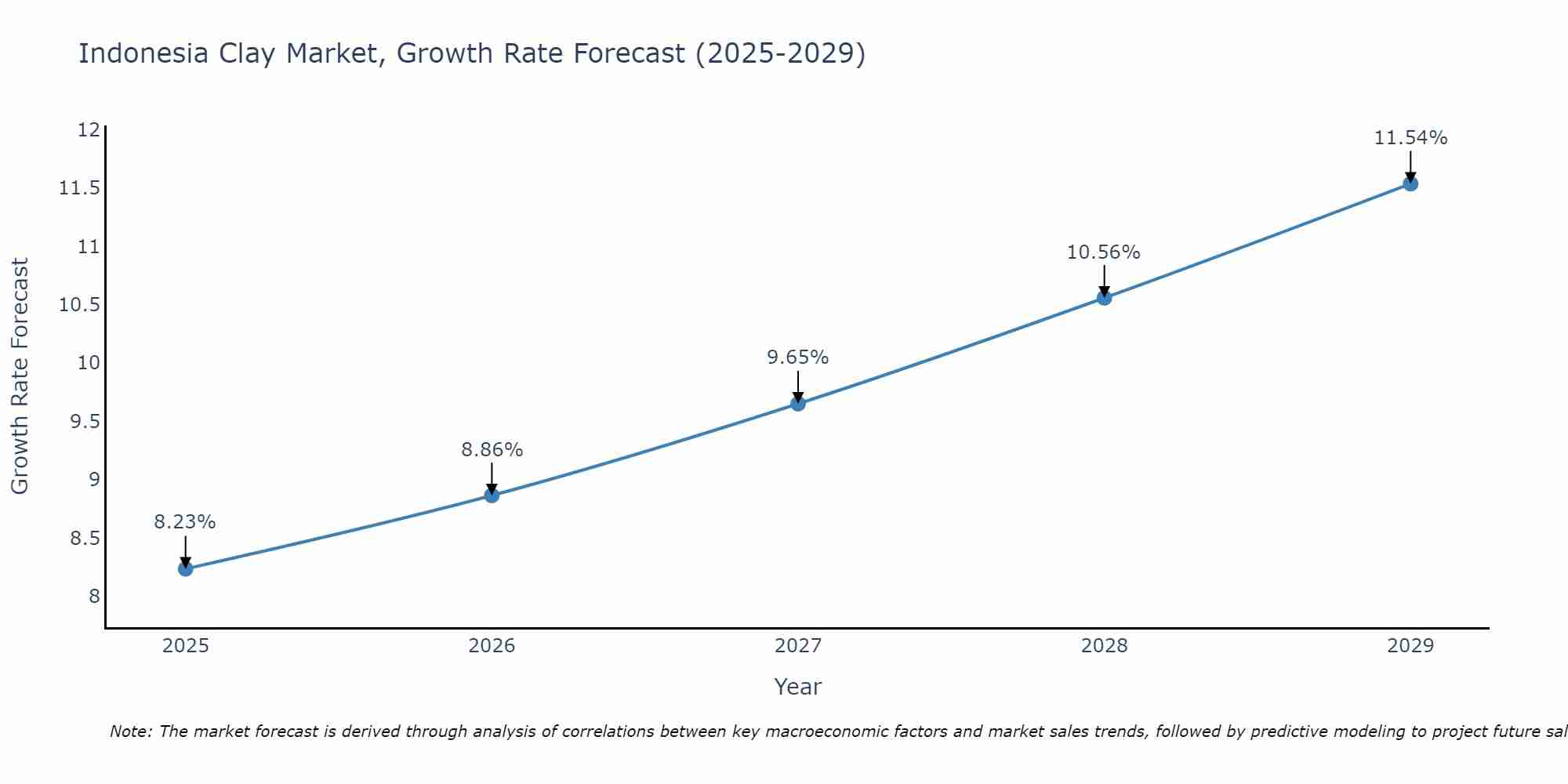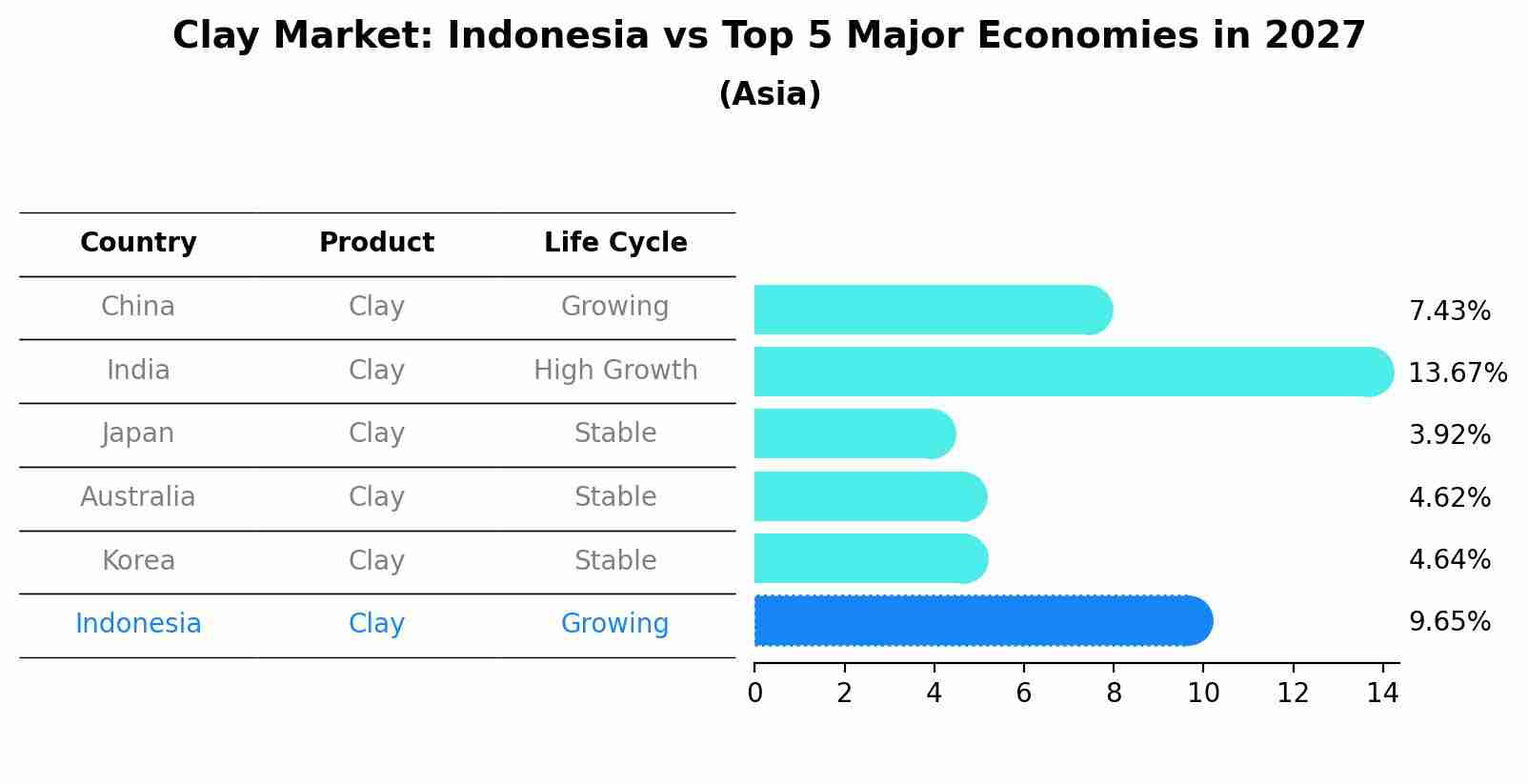Indonesia Clay Market (2025-2031) Outlook | Size, Industry, Companies, Revenue, Share, Growth, Value, Forecast, Trends & Analysis
| Product Code: ETC318988 | Publication Date: Aug 2022 | Updated Date: Aug 2025 | Product Type: Market Research Report | |
| Publisher: 6Wresearch | No. of Pages: 75 | No. of Figures: 35 | No. of Tables: 20 | |
Indonesia Clay Market Size Growth Rate
The Indonesia Clay Market is poised for steady growth rate improvements from 2025 to 2029. The growth rate starts at 8.23% in 2025 and reaches 11.54% by 2029.

Clay Market: Indonesia vs Top 5 Major Economies in 2027 (Asia)
In the Asia region, the Clay market in Indonesia is projected to expand at a growing growth rate of 9.65% by 2027. The largest economy is China, followed by India, Japan, Australia and South Korea.

Indonesia Clay Market Synopsis
The clay market value stood at USD 15 million as estimated in 2025 owing mainly due predominantly used for ceramic tile production, sanitary ware production, paints manufacturing, refractory bricks manufacturing etc., thus driving an array opportunities within domestic markets where it finds major usage as primary raw material for above stated products. Additionally, growing awareness regarding eco friendly construction practices involving sustainable building materials are likely support additional revenue generation avenues throughout analysis time frame.
Drivers of the Market
The Indonesia Clay market is projected to witness growth due to its applications in construction, ceramics, and various industrial processes. Clay is a versatile material used in brick making, pottery, and the production of ceramics and refractories. The country`s construction boom, urban development, and infrastructure projects contribute to the demand for clay products. Additionally, the ceramics and pottery industries, along with the growth of manufacturing sectors, further drive the market`s expansion. As industries emphasize material sustainability and innovation, collaborations between clay producers and end-users are expected to shape the market`s development.
Challenges of the Market
The Indonesia Clay Market is projected to grow steadily, driven by construction, ceramics, and other industries. Challenges may arise from the availability of high-quality clay deposits and environmental concerns related to mining activities. Embracing responsible mining practices and investing in research for alternative materials could help mitigate these challenges.
COVID-19 Impact on the Market
The clay market in Indonesia is linked to the construction and ceramics industries. The demand for clay is influenced by construction projects, infrastructure development, and manufacturing of ceramics. The pandemic`s impact on construction activity and supply chain disruptions could have affected the clay market.
Key Players in the Market
The Indonesia clay market has diverse applications across industries, including construction, ceramics, and industrial processes. The market outlook for clay is linked to the growth of these sectors, with clay being used in the production of bricks, tiles, and various ceramic products. The construction industry`s demand for sustainable building materials also plays a role in shaping the market. Key players in this market could include PT. Golden Stone Indonesia, PT. Sidoarjo Ceramic, and PT. Solusi Batako Nusantara.
Key Highlights of the Report:
- Indonesia Clay Market Outlook
- Market Size of Indonesia Clay Market, 2024
- Forecast of Indonesia Clay Market, 2031
- Historical Data and Forecast of Indonesia Clay Revenues & Volume for the Period 2021-2031
- Indonesia Clay Market Trend Evolution
- Indonesia Clay Market Drivers and Challenges
- Indonesia Clay Price Trends
- Indonesia Clay Porter's Five Forces
- Indonesia Clay Industry Life Cycle
- Historical Data and Forecast of Indonesia Clay Market Revenues & Volume By Application for the Period 2021-2031
- Historical Data and Forecast of Indonesia Clay Market Revenues & Volume By Tableware for the Period 2021-2031
- Historical Data and Forecast of Indonesia Clay Market Revenues & Volume By Sanitary ware for the Period 2021-2031
- Historical Data and Forecast of Indonesia Clay Market Revenues & Volume By Medical applications for the Period 2021-2031
- Historical Data and Forecast of Indonesia Clay Market Revenues & Volume By End Use for the Period 2021-2031
- Historical Data and Forecast of Indonesia Clay Market Revenues & Volume By Ceramic and for the Period 2021-2031
- Historical Data and Forecast of Indonesia Clay Market Revenues & Volume By Non-ceramic for the Period 2021-2031
- Indonesia Clay Import Export Trade Statistics
- Market Opportunity Assessment By Application
- Market Opportunity Assessment By End Use
- Indonesia Clay Top Companies Market Share
- Indonesia Clay Competitive Benchmarking By Technical and Operational Parameters
- Indonesia Clay Company Profiles
- Indonesia Clay Key Strategic Recommendations
Frequently Asked Questions About the Market Study (FAQs):
1 Executive Summary |
2 Introduction |
2.1 Key Highlights of the Report |
2.2 Report Description |
2.3 Market Scope & Segmentation |
2.4 Research Methodology |
2.5 Assumptions |
3 Indonesia Clay Market Overview |
3.1 Indonesia Country Macro Economic Indicators |
3.2 Indonesia Clay Market Revenues & Volume, 2021 & 2031F |
3.3 Indonesia Clay Market - Industry Life Cycle |
3.4 Indonesia Clay Market - Porter's Five Forces |
3.5 Indonesia Clay Market Revenues & Volume Share, By Application, 2021 & 2031F |
3.6 Indonesia Clay Market Revenues & Volume Share, By End Use, 2021 & 2031F |
4 Indonesia Clay Market Dynamics |
4.1 Impact Analysis |
4.2 Market Drivers |
4.2.1 Increasing demand for clay in construction and infrastructure projects in Indonesia |
4.2.2 Growth in the ceramics and pottery industry, driving the demand for clay |
4.2.3 Government initiatives promoting the use of locally sourced materials like clay |
4.3 Market Restraints |
4.3.1 Fluctuating raw material prices impacting the cost of production |
4.3.2 Environmental regulations and concerns over clay mining practices |
4.3.3 Competition from alternative materials in various industries |
5 Indonesia Clay Market Trends |
6 Indonesia Clay Market, By Types |
6.1 Indonesia Clay Market, By Application |
6.1.1 Overview and Analysis |
6.1.2 Indonesia Clay Market Revenues & Volume, By Application, 2021-2031F |
6.1.3 Indonesia Clay Market Revenues & Volume, By Tableware, 2021-2031F |
6.1.4 Indonesia Clay Market Revenues & Volume, By Sanitary ware, 2021-2031F |
6.1.5 Indonesia Clay Market Revenues & Volume, By Medical applications, 2021-2031F |
6.2 Indonesia Clay Market, By End Use |
6.2.1 Overview and Analysis |
6.2.2 Indonesia Clay Market Revenues & Volume, By Ceramic and, 2021-2031F |
6.2.3 Indonesia Clay Market Revenues & Volume, By Non-ceramic, 2021-2031F |
7 Indonesia Clay Market Import-Export Trade Statistics |
7.1 Indonesia Clay Market Export to Major Countries |
7.2 Indonesia Clay Market Imports from Major Countries |
8 Indonesia Clay Market Key Performance Indicators |
8.1 Average selling price of clay products |
8.2 Number of construction permits issued in Indonesia |
8.3 Clay import/export volume |
8.4 Investment in RD for clay product development |
8.5 Utilization rate of clay processing facilities |
9 Indonesia Clay Market - Opportunity Assessment |
9.1 Indonesia Clay Market Opportunity Assessment, By Application, 2021 & 2031F |
9.2 Indonesia Clay Market Opportunity Assessment, By End Use, 2021 & 2031F |
10 Indonesia Clay Market - Competitive Landscape |
10.1 Indonesia Clay Market Revenue Share, By Companies, 2024 |
10.2 Indonesia Clay Market Competitive Benchmarking, By Operating and Technical Parameters |
11 Company Profiles |
12 Recommendations |
13 Disclaimer |
- Single User License$ 1,995
- Department License$ 2,400
- Site License$ 3,120
- Global License$ 3,795
Search
Related Reports
- ASEAN Bearings Market (2025-2031) | Strategy, Consumer Insights, Analysis, Investment Trends, Opportunities, Growth, Size, Share, Industry, Revenue, Segments, Value, Segmentation, Supply, Forecast, Restraints, Outlook, Competition, Drivers, Trends, Demand, Pricing Analysis, Competitive, Strategic Insights, Companies, Challenges
- Europe Flooring Market (2025-2031) | Outlook, Share, Industry, Trends, Forecast, Companies, Revenue, Size, Analysis, Growth & Value
- Saudi Arabia Manlift Market (2025-2031) | Outlook, Size, Growth, Trends, Companies, Industry, Revenue, Value, Share, Forecast & Analysis
- Uganda Excavator, Crane, and Wheel Loaders Market (2025-2031) | Strategy, Consumer Insights, Analysis, Investment Trends, Opportunities, Growth, Size, Share, Industry, Revenue, Segments, Value, Segmentation, Supply, Forecast, Restraints, Outlook, Competition, Drivers, Trends, Demand, Pricing Analysis, Competitive, Strategic Insights, Companies, Challenges
- Rwanda Excavator, Crane, and Wheel Loaders Market (2025-2031) | Strategy, Consumer Insights, Analysis, Investment Trends, Opportunities, Growth, Size, Share, Industry, Revenue, Segments, Value, Segmentation, Supply, Forecast, Restraints, Outlook, Competition, Drivers, Trends, Demand, Pricing Analysis, Competitive, Strategic Insights, Companies, Challenges
- Kenya Excavator, Crane, and Wheel Loaders Market (2025-2031) | Strategy, Consumer Insights, Analysis, Investment Trends, Opportunities, Growth, Size, Share, Industry, Revenue, Segments, Value, Segmentation, Supply, Forecast, Restraints, Outlook, Competition, Drivers, Trends, Demand, Pricing Analysis, Competitive, Strategic Insights, Companies, Challenges
- Angola Excavator, Crane, and Wheel Loaders Market (2025-2031) | Strategy, Consumer Insights, Analysis, Investment Trends, Opportunities, Growth, Size, Share, Industry, Revenue, Segments, Value, Segmentation, Supply, Forecast, Restraints, Outlook, Competition, Drivers, Trends, Demand, Pricing Analysis, Competitive, Strategic Insights, Companies, Challenges
- Israel Intelligent Transport System Market (2025-2031) | Strategy, Consumer Insights, Analysis, Investment Trends, Opportunities, Growth, Size, Share, Industry, Revenue, Segments, Value, Segmentation, Supply, Forecast, Restraints, Outlook, Competition, Drivers, Trends, Demand, Pricing Analysis, Competitive, Strategic Insights, Companies, Challenges
- Uganda Precast and Aggregate Market (2025-2031) | Strategy, Consumer Insights, Analysis, Investment Trends, Opportunities, Growth, Size, Share, Industry, Revenue, Segments, Value, Segmentation, Supply, Forecast, Restraints, Outlook, Competition, Drivers, Trends, Demand, Pricing Analysis, Competitive, Strategic Insights, Companies, Challenges
- Australia IT Asset Disposal Market (2025-2031) | Strategy, Consumer Insights, Analysis, Investment Trends, Opportunities, Growth, Size, Share, Industry, Revenue, Segments, Value, Segmentation, Supply, Forecast, Restraints, Outlook, Competition, Drivers, Trends, Demand, Pricing Analysis, Competitive, Strategic Insights, Companies, Challenges
Industry Events and Analyst Meet
Our Clients
Whitepaper
- Middle East & Africa Commercial Security Market Click here to view more.
- Middle East & Africa Fire Safety Systems & Equipment Market Click here to view more.
- GCC Drone Market Click here to view more.
- Middle East Lighting Fixture Market Click here to view more.
- GCC Physical & Perimeter Security Market Click here to view more.
6WResearch In News
- Doha a strategic location for EV manufacturing hub: IPA Qatar
- Demand for luxury TVs surging in the GCC, says Samsung
- Empowering Growth: The Thriving Journey of Bangladesh’s Cable Industry
- Demand for luxury TVs surging in the GCC, says Samsung
- Video call with a traditional healer? Once unthinkable, it’s now common in South Africa
- Intelligent Buildings To Smooth GCC’s Path To Net Zero













